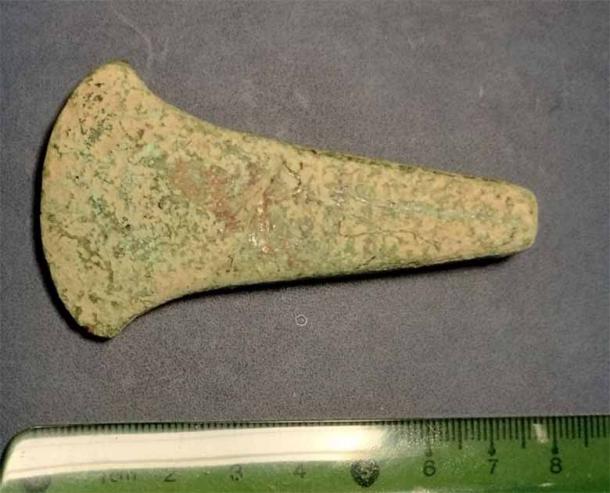
Lost in Time and Out of Place: Trypillia Copper Axe is Poland’s Oldest
A remarkable discovery has been made in eastern Poland. Archaeologists have unearthed a copper axe in Poland’s Hrubieszów district which looks for all the world like it belongs to the ancient Trypillia culture.
This would date the find to a period between the 4th and 3rd millennium BC and make the axe the oldest copper artifact ever discovered in Poland. There is however a problem: the Trypillia culture was never in Poland.
A Lost Axe, Found
The axe itself is only small, and we can only guess as to what its exact purpose was. The Lublin Provincial Conservator of Monuments describes it as being made of copper and 7.4cm (3”) in length with a wide fan-shaped blade 4.1cm (1.6”) wide, and a rectangular convex head measuring 0.9cm x 0.6cm (0.3” x 0.2”), reports Heritage Daily.
- The Sharp Edge of a Viking Axe - Cut Out for More than One Job
- The Copper Age: When Metallurgy Came to Rule the World

The copper axe is only small, and its simplicity points to a Neolithic origin. Did the Trypillia make this? (Lublin Provincial Conservator of Monuments / Arkeonews)
When it was initially uncovered it was a complete mystery to the archaeologists, who had never seen anything like it before. The axe did not look like anything known from the Bronze Age in that region, and its simplicity and shape suggested it could be Neolithic. This would make it an extremely early example of metalworking.
“Our axe was made in a quite simple ‘primitive’ casting method in a flat-convex form, no longer used in the developed metallurgy of the Bronze Age. Therefore, it was necessary to pay attention to the earlier Neolithic era. Unfortunately, in the inventories of Neolithic cultures from Poland there is no such equivalent,” the Lublin conservator noted as reported in Arkeonews.
Given it did not resemble anything known from Neolithic cultures in Poland, either, it seemed to defy our understanding. It would take another discovery, in the neighboring Ukraine, to finally provide an answer.
- Native North Americans Were Making Copper Tools in 7,500 BC
- 27 Pounds of Copper Age Axe and Hammer Heads is the Largest European Hoard of its Kind

The Trypillia culture (known as Cucuteni in Romania) expanded over much of southeastern Europe and it certainly looks like they made the copper axe, but they never made it to Poland (Saukkomies / Public Domain)
Another axe with a very similar design had been found near Kyiv. Accompanying pottery fragments recovered with that find conclusively tied the Kyiv axe to the Trypillia culture, who flourished in southeastern Europe during the Neolithic-Chalcolithic period.
The Trypillia themselves are also something of a mystery. They are perhaps most famous for routinely burning their settlements to the ground before rebuilding them, an act of wanton destruction with an unclear purpose.
They existed in what is now Bulgaria, Romania, Moldova and the west of Ukraine, but they never spread to the territories of modern Poland. This axe, then, far from the Trypillia heartlands, would seem to have something to tell us about ancient trade across eastern Europe.
The axe seems to prove that the Trypillia had established trade routes to the west of their culture, and that the axe travelled to Poland along these routes. The discovery of more pottery fragments in the Polish village of Gródek could be further evidence of this trade between the Trypillia and their western neighbors.
Or could it mean something else? Could these be the first discoveries which show the territory of the Trypillia extended further west than previously thought? Are there lost settlements from this culture in Poland, waiting to be discovered?
The axe itself will be taken to the Hrubieszów Museum for further study. For now its discovery and association with this ancient Neolithic people means it very well could be the oldest copper artifact ever recovered in Poland.
Top Image: The copper axe seems to have been made by the Trypillia, but their culture never made it as far west as Poland. Source: Lublin Provincial Conservator of Monuments / Heritage Daily.
By Joseph Green















